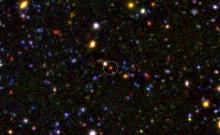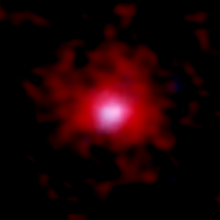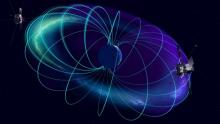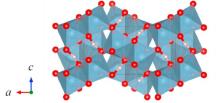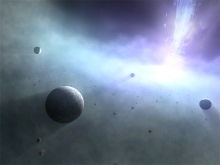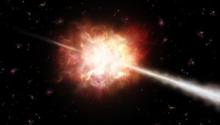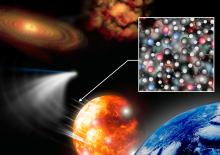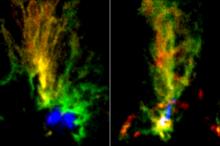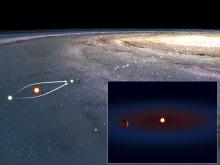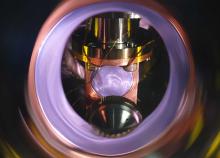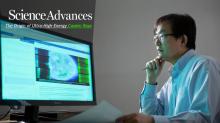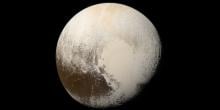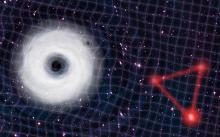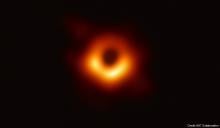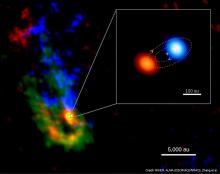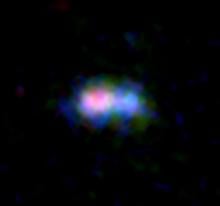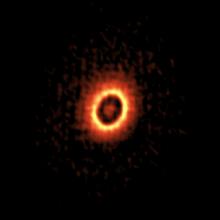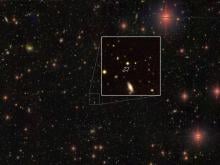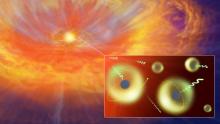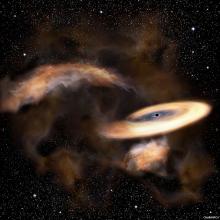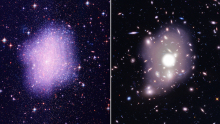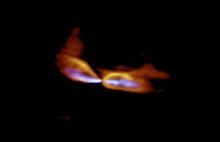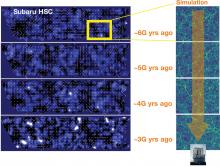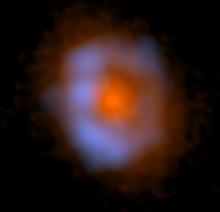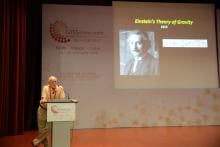Space sciences
News
16 Dec 2019
Researchers have discovered gigantic clouds of gaseous carbon more than a radius of 30,000 light-years around young galaxies using ALMA.
13 Dec 2019
JAXA and NASA satellite observations show where killer electrons are generated in the Van Allen radiation belts surrounding Earth.
10 Dec 2019
A new hydrous phase, ε-AlOOH, was observed to be stable at pressures above ~200 GPa. The stability of ε-AlOOH at extremely high pressures may affect the modelling results of the internal structure and deep water circulation of some extra-solar planets, such as terrestrial super-Earths, because the hydroxide may store water in these regions.
25 Nov 2019
Theoreticians in two different fields defied the common knowledge that planets orbit stars like the Sun. They proposed the possibility of thousands of planets around a supermassive black hole.
20 Nov 2019
An international team of researchers have observed a gamma-ray burst, an extremely energetic flash following a cosmological cataclysm, emitting very-high-energy gamma-rays long after the initial explosion.
19 Nov 2019
Using the Cooled Mid-Infrared Camera and Spectrometer on the Subaru Telescope, astronomers have detected an unidentified infrared emission band from comet 21P/Giacobini-Zinner in addition to the thermal emissions from silicate and carbon grains.
14 Nov 2019
Two peacock-shaped gaseous clouds were revealed in the Large Magellanic Cloud by observations with Atacama Large Millimeter/submillimeter Array.
01 Nov 2019
Researchers using telescopes around the world confirmed and characterized an exoplanet orbiting a nearby star through gravitational microlensing.
27 Sep 2019
An experiment shows that one of the basic units of life — nucleobases — could have originated within giant gas clouds interspersed between the stars.
28 Aug 2019
An international team has used AI to create a 3D simulation of the Universe.
27 Aug 2019
Chair Professor Il Soon Hwang, who joined the School of Mechanical Aerospace and Nuclear Engineering at South Korea's Ulsan National Institute of Science and Technology (UNIST), has been selected to lead the 'Nuclear Convergence Technology Development' project by the Ministry of Science and ICT (MSIT) and National Research Foundation (NRF).
26 Aug 2019
A recent study, affiliated with South Korea's Ulsan National Institute of Science and Technology (UNIST) has unveiled the dynamics of the bloch point in an asymmetric permalloy disk.
26 Aug 2019
A recent study, affiliated with South Korea's Ulsan National Institute of Science and Technology (UNIST) has shed new light on the mysterious origin of such ultra-high-energy cosmic rays (UHECRs) that has puzzled astrophysicists for decades.
20 May 2019
A gassy insulating layer beneath the icy surfaces of distant celestial objects could mean there are more oceans in the universe than previously thought.
26 Apr 2019
An international team of researchers has discovered a novel method that might verify the existence of a new hypothetical type of particle, namely ultralight bosons, by using observation of the gravitational waves emitted by a smaller black hole orbiting a larger black hole.
11 Apr 2019
Japanese researchers contribute to paradigm-shifting observations of the gargantuan black hole at the heart of distant galaxy Messier 87.

02 Apr 2019
An international team has found evidence dark matter may not be made of tiny black holes.
28 Mar 2019
Astronomers have found a molecular cloud that is collapsing to form two massive protostars that will eventually become a binary star system. This observations show that binary stars form together.

22 Mar 2019
The Hong Kong University of Science and Technology (HKUST) (HKUST) will build a new kind of camera using a new approach of quantum optics. The camera is set to help solve unanswered questions in astrophysics and cosmology, such as how light originates and varies around the black hole, in the hope of deciphering information emitted from there.
20 Mar 2019
Researchers have detected a radio signal from abundant interstellar dust in MACS0416_Y1, a galaxy 13.2 billion light-years away in the constellation Eridanus. Standard models can’t explain this much dust in a galaxy this young, forcing us to rethink the history of star formation.
13 Mar 2019
Researchers spotted the formation sites of planets around a young star resembling our Sun. Two rings of dust around the star, at distances comparable to the asteroid belt and the orbit of Neptune in our Solar System, suggest that we are witnessing the formation of a planetary system similar to ours.
13 Mar 2019
A team of astronomers has discovered 83 quasars powered by supermassive black holes (SMBHs) in the early Universe. This increases the number of black holes known at that epoch considerably, and reveals, for the first time, how common SMBHs were early in the Universe's history.
13 Mar 2019
A team of experts in nuclear fusion and astronomy has computed high-accuracy atomic data for analyzing light from a kilonova, a birth place of heavy elements. They found that their new data set could predict kilonovae brightness with much better accuracy than before. This aids our understanding of the cosmic origins of heavy elements.
28 Feb 2019
Astronomers have detected a stealthy black hole from its effects on an interstellar gas cloud. This intermediate mass black hole is one of over 100 million quiet black holes expected to be lurking in our Galaxy. These results provide a new method to search for other hidden black holes and help us understand the growth and evolution of black holes.
27 Feb 2019
New study finds dark matter may scatter against each other only when they hit the right energy, which could explain why galaxies from the smallest to the biggest have the shapes they do.
26 Feb 2019
Astronomers have unveiled the origins of two different gas streams from a baby star. Using ALMA, they found that the slow outflow and the high speed jet from a protostar have misaligned axes and that the former started to be ejected earlier than the latter. These indicate that streams were launched from different parts of disk around the protostar.
12 Feb 2019
Images of more than ten million galaxies are helping physicists map dark matter, revealing clues about how the universe behaves.
05 Feb 2019
Astronomers using ALMA have detected various complex organic molecules around the young star V883 Ori. A sudden outburst from this star is releasing molecules from the icy compounds in the planet forming disk.
31 Jan 2019
“It’s not that Newton’s theory was wrong,” says Professor Barry Barish, an experimental physicist from the California Institute of Technology and University of California, Riverside. “It was just incomplete and didn’t describe all of nature,” he says.
Events
Sorry, nothing coming up for this discipline
Researchers
Sorry, nothing coming up for this discipline
Giants in history
Sorry, nothing coming up for this discipline


